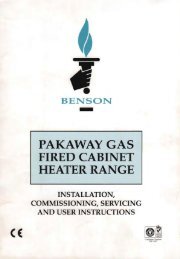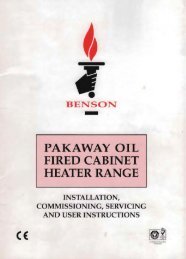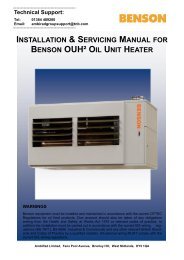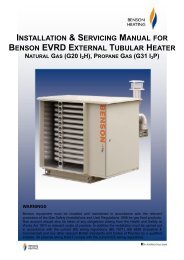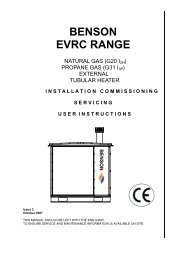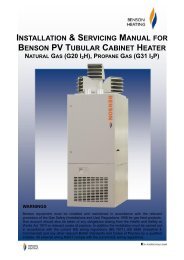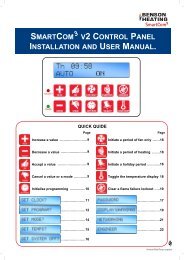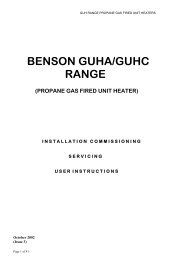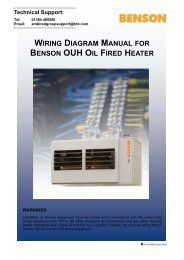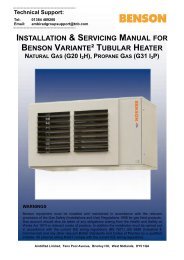BENSON VARIANTE RANGE
Benson BV Range
Benson BV Range
- No tags were found...
You also want an ePaper? Increase the reach of your titles
YUMPU automatically turns print PDFs into web optimized ePapers that Google loves.
Caution<br />
It is imperative that the flue should be<br />
properly sealed where it passes through the<br />
roof, this can best be achieved by using the<br />
approved method of roof flashing plate and<br />
cravat. The flue spigot outlet on all Variante<br />
heaters is in horizontal configuration.<br />
Note<br />
It should be noted that claims made under<br />
warranty and attributed to the ingress of<br />
water may not be considered especially if an<br />
approved method of sealing has not been<br />
used, or if the design of the flue has not<br />
made provision for possible condensation<br />
problems.<br />
It is also recommended that BS5854: 1980<br />
and BS5440: parts 1 and 2 are used as a<br />
consultative document when considering flue<br />
requirements.<br />
If terminating through a wall only use Benson<br />
approved horizontal terminals<br />
2.6 Electrical Installation<br />
All electrical wiring and connections must be<br />
in accordance with the relevant European,<br />
National, and Local regulations as well as to<br />
IEE Standards.<br />
Ensure that the Electric and Gas supplies are<br />
turned off before any electrical work is<br />
carried out on the heater.<br />
Also ensure that wiring cannot make contact<br />
with any metal surfaces liable to be subject<br />
to high temperatures, and where insulation of<br />
the wiring could be impaired as a result of<br />
such contact.<br />
All Variante models must be earthed.<br />
Warning<br />
Ensure that the electrical supply is<br />
compatible to the heater.<br />
ALL HEATERS ARE NEUTRALLY RESET<br />
Caution<br />
The main electrical supply must not be<br />
switched off or disconnected as a method for<br />
stopping the heater, the exception to this is in<br />
the event of an emergency, or when the<br />
heater has been allowed to cool sufficiently<br />
to prevent any damage from being sustained<br />
to the heater or its controls (ie: during<br />
servicing).<br />
Claims for damage will not be considered if<br />
they have resulted from incorrect wiring or<br />
the incorrect use of the heater<br />
Each heater requires a permanent 230V<br />
50Hz 1ph electrical supply, which must be<br />
wired through a fused isolator fitted with a<br />
fuse of the correct rating (see section 7.1).<br />
The correct supply connection points for the<br />
live, neutral, and earth.<br />
Wiring diagrams are also detailed within this<br />
manual, (section 6.0 )<br />
The electrical supply isolator should be<br />
mounted adjacent to the air heater in an<br />
easily accessible position to allow for<br />
servicing isolation, or emergency shut off.<br />
Electrical panel<br />
Warning<br />
Ensure that the mains isolator is turned OFF<br />
before undertaking any electrical work on the<br />
heater. Access to the electrical panel is<br />
gained by opening the right hand heater side<br />
panel.<br />
Warning<br />
Ensure that all connections are secure and<br />
that there are no loose strands which could<br />
bridge across the terminals.<br />
A minimum conductor size of 1.0 mm<br />
(diameter) is required.<br />
Remote Control Panels Warning<br />
Isolate panel before working on heater<br />
Caution<br />
When using CP4 Optimised Controller<br />
Consideration should be made when routing<br />
the cable between the control and heater.<br />
Avoiding where possible any existing cables<br />
and switch gear as any induced voltage may<br />
affect the operation of the sequential control<br />
box within the heater.<br />
It is recommended that screened cable is<br />
used when the control is to be sited more<br />
than 10 metres away from the heater<br />
One electrical panel per heater is required,<br />
unless heaters are specified for multiple<br />
heater control applications. On no account<br />
should more than one heater be connected<br />
to a single time switch or thermostat.<br />
The only exception to this is when a control<br />
panel suitable for multiple heater applications<br />
is supplied by the manufacturer.<br />
19



